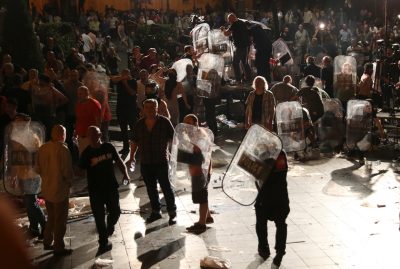Escalating Color Revolution: The “Georgian Dream” Might Turn into an American Nightmare

The ruling “Georgian Dream” party of the former Soviet Republic of Georgia is at risk of falling in the face of an ever-escalating Color Revolution that was preplanned to coincide with the symbolic visit of a Russian parliamentarian during the ongoing Inter-Parliamentary Assembly on Orthodoxy meeting in the South Caucasian country’s capital, possibly giving way to an American nightmare afterwards if this regime change plot succeeds and ends up forcing Russia on the defensive on yet another former Soviet front.
The Republic of Georgia is in the throes of an ever-escalating Color Revolution that abruptly broke out in response to the symbolic visit of a Russian parliamentarian during the ongoing Inter-Parliamentary Assembly on Orthodoxy (IAO) meeting in the South Caucasian country’s capital. The ruling “Georgian Dream” party is under fire for allowing IAO chairman and Duma deputy Sergei Gavrilov from the Russian Communist Party to address the gathering in his native language from the Georgian parliamentarian chairman’s seat, with the opposition regarding this as a provocative affront to their state’s sovereignty given the absence of formal relations between the two countries since Russia’s 2008 peace-enforcement mission. Furthermore, rumors abounded that Gavrilov had supported the Abkhaz separatists in the 1990s, though the foreign official denied the accusations and instead insisted that “Russia and Georgia are united by fraternal Orthodox ties”.
His trip to Georgia was supposed to have been an apolitical event aimed at achieving Orthodox-facilitated reconciliation between these two neighboring countries, with it having been entirely predictable that he’d address the assembly in this year’s host state seeing as how protocol naturally calls for the chairman to do so. Nevertheless, because the scheduled event and Gavrilov’s role in it obviously weren’t a secret, this allowed the opposition to prepare for carrying out a preplanned provocation designed to topple the ruling “Georgian Dream” party for its pragmatic stance towards Russia after the previous attempt during last summer’s so-called “Rave Revolution” failed (even if it did serve in hindsight as a probing attempt to discern the security services’ vulnerabilities). Accordingly, some opposition members stormed out of the meeting when Gavrilov stepped up to the podium and then proceeded to call on their compatriots to stage a massive protest outside of parliament in response.
The resultant Color Revolution attempt turned downtown Tbilisi into a war zone after the riot police were forced to respond with tear gas and rubber bullets following the opposition’s attack against parliament. The country is now bracing for a second wave of unrest this weekend as the anti-government rioters demand the resignation of several top officials, which if successful would basically amount to regime change against the ruling “Georgian Dream” party. Prime Minister Mamuka Bakhtadze attempted to mitigate the public’s anger by describing events as a “fair protest” that was triggered by the “huge mistake” of letting Gavrilov address the assembly from the Georgian parliamentarian chairman’s seat but blamed “destructive forces” for hijacking the demonstrations. French-born President Salome Zurabishvili, who ran as an Independent but in an alliance with the “Georgian Dream” party, sensed her coalition partner’s weakness and pounced by accusing a Russian “fifth column” of being behind the unrest, implying that some in the state might have been involved in a conspiracy.
Chaos theory teaches that the outcome of complex processes is disproportionately dependent on the initial conditions, so bearing in mind that Color Revolutions are essentially the weaponization of this concept, it’s possible to make some predictions about the direction that the latest events are headed. It’s obvious that this was a preplanned provocation that exploited preexisting tensions and was timed to coincide with the “trigger event” of Gavrilov making his IAO speech from the Georgian parliamentarian chairman’s seat. The opposition’s walk-out stunt and subsequent rabble-rousing fanned the flames of ultra-nationalist sentiment that were quickly corralled in the direction of parliament and against the ruling party, succeeding in causing a split between the Independent President and her ruling “Georgian Dream” coalition partners. If the targeted authorities don’t resign, then the demonstrations will probably increase in fervor, probably culminating in more violence and/or a constitutional crisis if the President seeks to dismiss some officials against their will.
In terms of the larger picture, the latest unrest serves American grand strategic interests by forcing Russia to react to yet another crisis on its periphery, thereby tightening the “containment” noose that it’s set up in recent years throughout a slew of former Soviet Republics and forcing it on the defensive on yet another front. Furthermore, the possible loss of pragmatic partners in Georgia could further deteriorate Russia’s relations with the country, especially if a new ultra-nationalist government tries to expedite the state’s entry into NATO in spite of the unresolved status of Abkhazia and South Ossetia (which should technically make Georgia ineligible for membership). Even in the “best-case” scenario that the “Georgian Dream” doesn’t immediately give way to an American nightmare, it’s probable that the US and its EU partners might sanction the country under the pretext of supposed “unprovoked violence against peaceful protesters”, which could worsen the situation and eventually pave the way for yet another Color Revolution attempt in the coming future.
*
Note to readers: please click the share buttons above or below. Forward this article to your email lists. Crosspost on your blog site, internet forums. etc.
Andrew Korybko is an American Moscow-based political analyst specializing in the relationship between the US strategy in Afro-Eurasia, China’s One Belt One Road global vision of New Silk Road connectivity, and Hybrid Warfare. He is a frequent contributor to Global Research.
Featured image is from Reuters/Irakli Gedenidze

